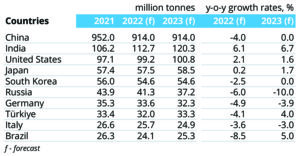
Top 10 Steel Consuming Countries (1 tonne = 1 mt = 1.1 tons).
The World Steel Association (WSA) recently released an update of its Short Range Outlook (SRO) for 2022 and 2023. It forecasts that steel demand will contract by 2.3% in 2022 to reach 1,796.7 million metric tons (mt) after increasing by 2.8% in 2021. In 2023, steel demand will see a recovery of 1% to reach 1,814.7 million mt. The current forecast represents a downward revision over the earlier forecast, reflecting the repercussion of persistently high inflation and rising interest rates globally, the WSA said. High inflation, monetary tightening, and China’s slowdown contributed to a difficult 2022, but infrastructure demand is expected to lift 2023 steel demand slightly.
The global economic environment deteriorated significantly in 2022 as inflation risk fully materialized along with other major headwinds, namely the Russia-Ukraine war and China’s lockdowns.
Supply chain problems eased somewhat in 2022, but continued to constrain production activities as new disruptions have emerged. Assuming that the war will not end soon and China continues to maintain its strict COVID containment policy for the time being, supply bottlenecks will not dissipate completely, despite slowing demand.
Steel demand in China contracted by 6.6% in the first eight months of 2022. For the whole year, steel demand is likely to fall by 4.0% with the low base effect of the second half of 2022. In 2023, new infrastructure projects and a mild recovery in the real estate market could prevent further contraction of steel demand. Steel demand in 2023 is expected to remain flat under the assumption that small new stimulus measures are to be introduced and lockdown measures will be largely removed in the later part of 2022. Significant downside risks exist if these assumptions are not met. The slowing global economy poses further downside risk for China.
Steel demand in the EU is expected to contract by 3.5% in 2022. With immediate improvement in the gas supply situation not in sight, steel demand in the EU will continue to contract in 2023 with a significant downside risk in case of harsh winter weather or further disruptions to energy supplies. Financial risks stemming from high public debts and slow growth in China pose further downside risks for the EU. There are also possible long-term consequences for the structure of the economy and hence steel demand if the economic constraints continue at the current level. On the other hand, if the Russia-Ukraine war ends sooner than expected, there is an upside potential.
The sustained and strong recovery of the U.S. economy from the pandemic shock is coming to an end. Manufacturing activities are expected to cool sharply thanks to the weak economic environment, strong dollar and shift of spending from goods to services. However, the automotive sector is expected to maintain the positive momentum on the back of pent-up demand and easing of supply chain constraints. The construction sector will struggle due to rising materials cost and high interest rates. The new Infrastructure Law will however sharply boost infrastructure investment, and rising energy sector investment will support growth in steel demand. Overall, U.S. steel demand is not expected to contract.
The recovery of steel demand in Japan weakened as rising materials cost and labor shortages have led to construction delays. However, with the support of the non-residential construction and machinery sectors, steel demand will continue its moderate recovery in 2022. Growth in the automotive industry with easing of supply chain constraints will allow for a continued recovery of steel demand in 2023.
The steel demand outlook for South Korea has worsened and is expected to decline in 2022 due to contracting facility investment and construction. Recovery in 2023 will be led by easing of auto supply chain bottlenecks and an improved outlook for ship deliveries and construction. However, recovery of manufacturing will be limited due to the weak global economy.
Both Japan and Korea face downside risks from the worsening global economic outlook as their steel using sectors have a high exposure to exports.
Steel demand in the developed world will fall by 1.7% and recover by 0.2% in 2022 and 2023 respectively, after recovering by 16.4% in 2021 from the pandemic dip of 12.3%.




